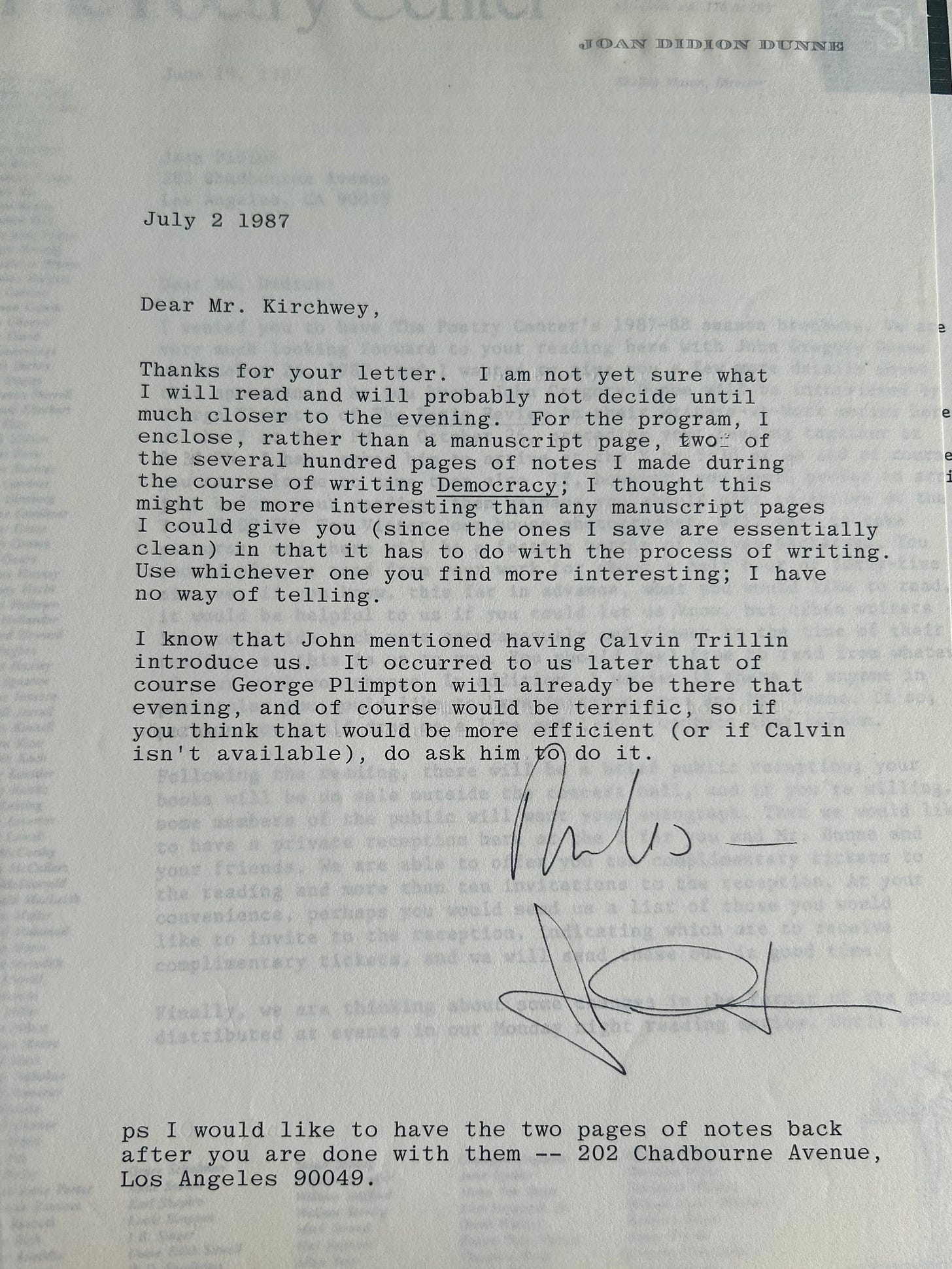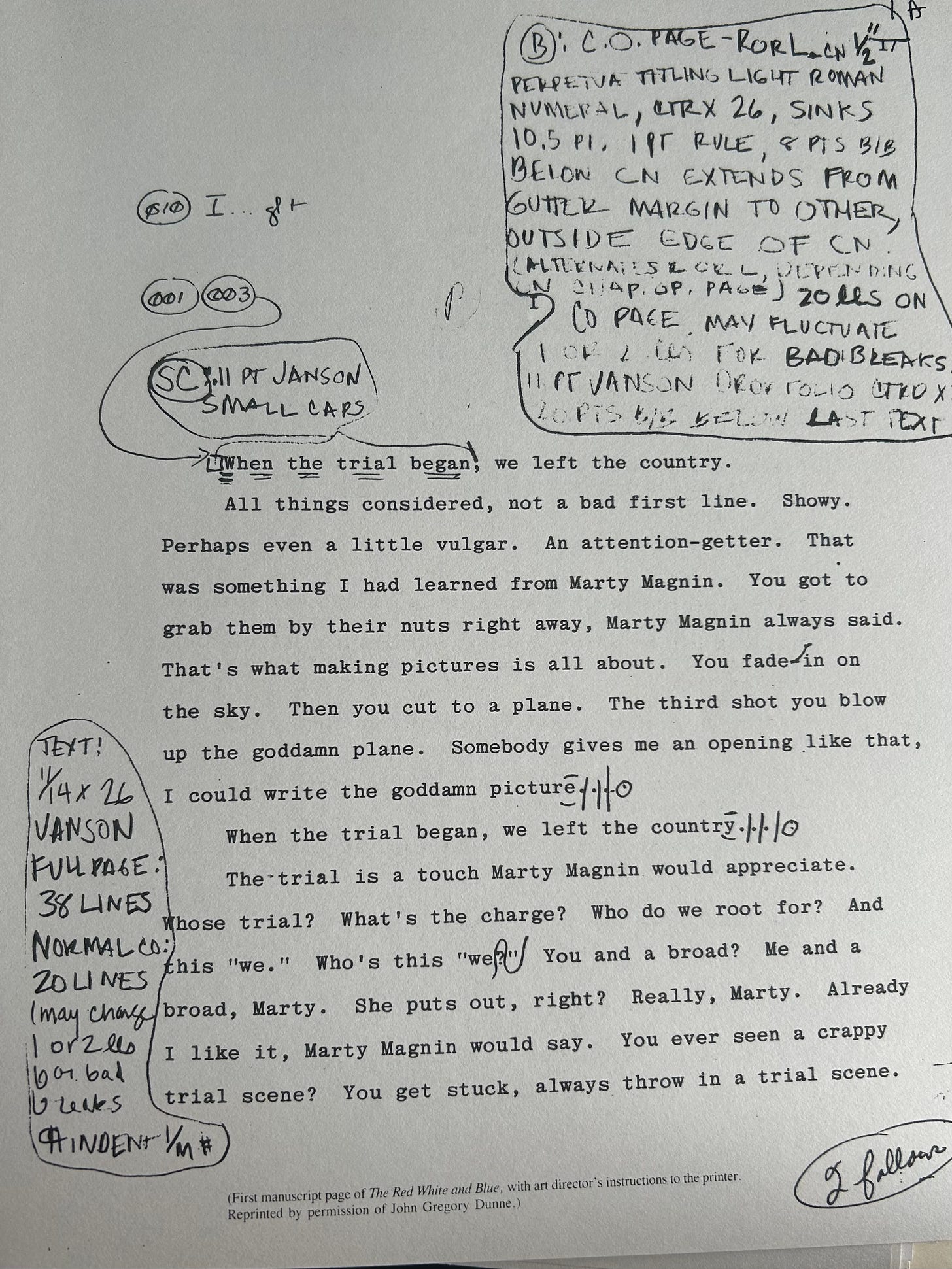Into the John Gregory Dunne Archives
"I drew a heart, and then I drew a square around the heart, and I was talking to my wife as I was doodling, and I found that I had written down the five letters V-E-G-A-S."
Joan Didion, as you likely know, went to Honolulu “in lieu of filing for divorce”. You may not know that her husband, John Gregory Dunne, absconded to a dingy apartment off the Las Vegas strip. She had her husband and child in tow, he went alone. Her writing on the subject was included in her seminal essay collection, The White Album. His was turned into a book that, until its recent reissue by McNally Editions, was a highly acclaimed, criminally underread classic entitled Vegas: A Memoir of a Dark Season, first published in 1974.
On June 12th, we are celebrating that reissue with a conversation between Stephanie Danler (the acclaimed memoirist and author of Sweetbitter, who wrote the introduction to the new edition), and John’s nephew, Griffin Dunne. John himself, of course, will not be joining us, but he did appear on stage at the 92nd Street Y, twice, both times on October 26th, 1987. The first appearance was an interview with George Plimpton for the Paris Review’s “Writers at Work” series, which included a fascinating conversation about Vegas, starting at around 18:20. I’ve transcribed it below, but I recommend listening to their conversation in full, especially because the Vegas discussion is followed by a fantastic exchange about writing sex scenes and going to confession.
The second appearance was a reading alongside Joan Didion, which I have also included below.
I spent a very pleasant afternoon thumbing through their (shared) file, which contains correspondence about these events. I have included some highlights below. There’s something about reading banal correspondence that I find very illuminating, I hope you do too, and that you’ll join us at the event! You can buy tickets here.
— Mikaela Dery, Director, Unterberg Poetry Center
John Gregory Dunne and George Plimpton in conversation
Vegas is a very interesting book because it started off as a non-fiction book. I had published The Studio in 1969, and I immediately signed a contract to do a book called Vegas which was about Las Vegas. That was the one book, by the way, where I can actually pinpoint the moment where it started. I was trying to think of an idea, and I was doodling at my desk, and I drew a heart, and then I drew a square around the heart, and I was talking to my wife as I was doodling, and I found that I had written down the five letters V-E-G-A-S. And so I not only had a subject but I had a title.
I thought it was going to be a non-fiction book, and I realized as soon as I signed the contract that I didn’t want to do it. The deal was for me to do a book very much like The Studio, which was sort of, a very objective third person account of this place, and I thought that I’d already done it in The Studio. I went through this terrible period of about 18-months where I didn’t do any work, [it was] writers block. Writers block, I once defined, as a failure of nerve more than anything else. You find that you can’t actually go to your typewriter, so you have to gut your way through something.
So I kept going over to Las Vegas, I had a duplex apartment in Las Vegas which I paid $145 a month, I had it for 13 months and I spent one night there in the 13- months that I had it. I furnished it, I got frying pans and collanders and knives and forks and whenever I went over to Las Vegas I never stayed in the apartment, I stayed in a motel. Why, I don’t know.
I made up most of the book, and as a result… I had a contract for a non-fiction book, and I thought of it as a novel. Random House thought it [didn’t] read like a novel, and I said a novel is anything a writer says the book is, and if indeed I made most of it up, it can’t be non-fiction. So we ended up calling it not a novel, and not non-fiction, it was billed as “a fiction”. I like to think of it as a novel. A lot of it is true. [One] true thing is that there was a prostitue, who did write poetry. The poetry that I use in the book is not hers, it was actually written by my wife who was a student of Sara Teasdale’s poetry, and she said, “I can write you bad poetry”, so those two little poems are actually Joan’s. The rest of the book was made up. I did meet a lot of comics, the private detective is not a whole cloth, I actually did talk to a private detective in Las Vegas and he was a real crazo, he thought he knew where Howard Hughes was, he thought he was in some little town in California, but actually he was in the top of one of those hotels in Las Vegas, which maybe wasn’t a very good proviate detective. The rest is just sort of made up. I think of it as my first novel.
Joan Didion reads from Democracy, John Gregory Dunne reads from Red, White and Blue.





More upcoming events!
June 14: It’s Dalloway Day!!! This year marks 100 years since Virginia Woolf's modernist masterpiece, Mrs. Dalloway, was published. We are celebrating with a full day reading of the entire book, with a litany of notable Dalloway fans including Susan Choi, Francine Prose, Sam Lipsyte, Jenny Offill, and many more! Your ticket allows you to come and go throughout the day. We’ll have tea, champagne, and cocktails available in the lobby (along with other surprises), and will be rounding out the reading with a screening of The Hours. Buy tickets here.
June 19: Before Toni Morrison wrote some of the greatest works of literature of our time, she was an editor at Random House. There, she discovered many incredible authors, including Gayle Jones, Lucille Clifton, and June Jordan. She personally selected Dana A. Williams to write about her luminous and underdiscussed career as an editor. Dana is joining us to discuss her book, Toni at Random, along with Lisa Lucas and Honorée Fanonne Jeffers. Buy tickets here.



